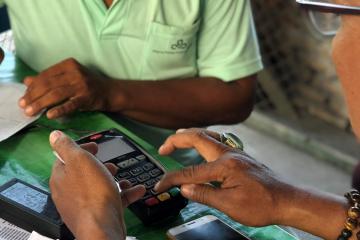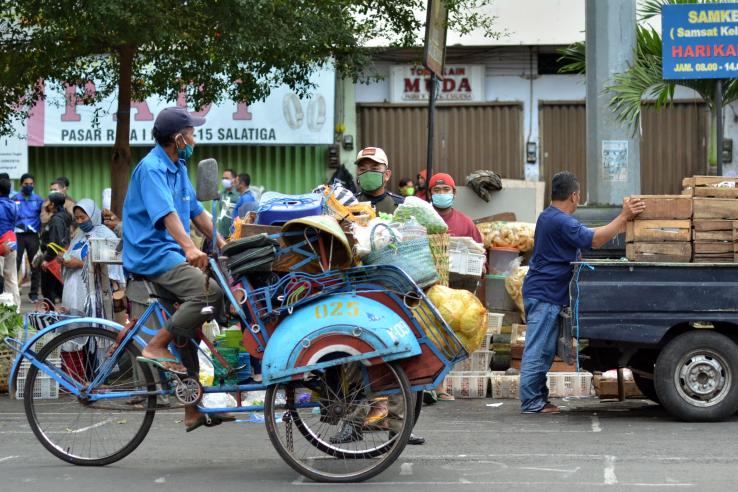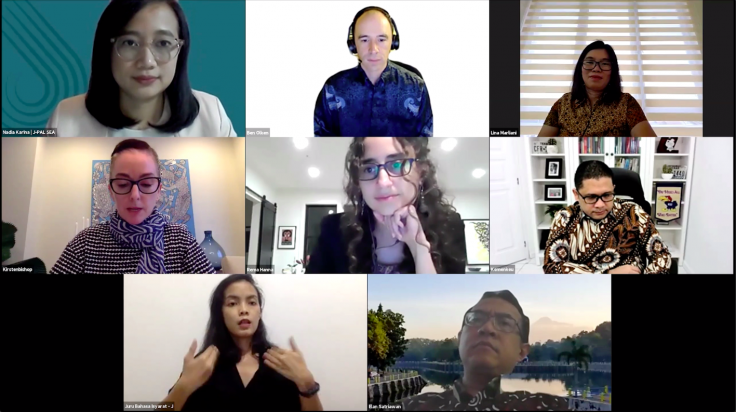
Strengthening Indonesia’s social protection in the COVID-19 era: Strategy and lessons from evidence

The COVID-19 crisis has created not only massive public health challenges but also an unprecedented economic shock for countries across the globe. Many people have lost their livelihoods due to the sudden slowdown of the economy and movement restrictions, setting back global poverty alleviation efforts. On top of that, emerging economies have more budgetary limitations to providing social assistance and are characterized by large informal sectors, making it more challenging to cushion the impacts of the crisis on the poor and the new vulnerable individuals.
Indonesia has massively expanded its social assistance programs to respond to the crisis. However, with more beneficiaries and a larger scale crisis, a new question arises: How can we strengthen existing institutions as a backbone to provide assistance to the crisis?
As a commitment to support the Indonesian government in mitigating the economic impact of COVID-19, J-PAL Southeast Asia (SEA) hosted a webinar on September 22 on “Social Protection in the COVID-19 Era: What can the evidence tell us?” featuring Indonesia’s Head of Fiscal Agency of the Ministry of Finance, Febrio Kacaribu, J-PAL SEA Co-Scientific Directors Rema Hanna (Harvard) and Benjamin Olken (MIT), and the Chief of the Policy Working Group of Indonesia’s National Team for the Acceleration of Poverty Reduction (TNP2K), Elan Satriawan, as moderator.
In his keynote speech, Mr. Kacaribu highlighted Indonesia’s investment in social protection programs amounting to IDR203 trillion, the largest allocation from the National Economic Recovery Program (Pemulihan Ekonomi Nasional/PEN). The programs are expanded to protect not only the current poor against major shocks, but also the growing number of new middle-income individuals and small businesses who have become vulnerable due to sudden loss of income. The government has increased the coverage and benefit levels of existing assistance programs while also introducing several new schemes to reach the newly vulnerable groups, including pre-employment cards, cash assistance for micro, small, and medium-sized enterprises, and wage subsidies for formal workers. Currently, the government’s priority is to ensure the effective delivery and implementation of these programs.
“We want the fund that has been budgeted to be received by the intended recipients faster so it can help their livelihoods.” – Febrio Kacaribu (Indonesia’s Head of Fiscal Agency of the Ministry of Finance)
Lessons from existing evidence to support Indonesia’s social protection programs during COVID-19
To support the Indonesian government in rapidly expanding social protection programs, Rema Hanna and Benjamin Olken presented lessons from existing evidence to improve the design of the social protection system to be more flexible in addressing the ongoing and upcoming challenges. Four critical aspects of social protection programs were highlighted:
Financing
With the uncertainty of the crisis, designing policy to respond to the dynamic public health situation can be costly. The government needs to provide adequate social protections to accompany the stay-at-home recommendation. This is necessary not only for a humanitarian reason (helping people survive) but also to reduce the need to go outdoors to generate an income, making social distancing or lockdowns more effective.
Moreover, social protection can be designed to adjust to the public health situation. One idea is to automatically link social protection to region-specific health or lockdown measures. For example, in Indonesia, the social protection policy can be tied to the green, yellow, orange, and red categories of COVID-19 health situation. Hence, when a region faces more severe health and lockdown situations, it would automatically trigger a more generous social protection policy. This enables direct compensation and provides a cushion if a region needs to go back into a tighter social distancing policy.
Targeting
With a new group of people facing a sudden shock, determining the right beneficiaries becomes more challenging. Improving the beneficiaries database can help us be more flexible and prepare better for future crises. While a proxy means tests (PMT)—one of the most common indirect measures of income—is useful for identifying those living in long-term poverty, it might not accurately identify the new vulnerable individuals.
The notion of community-based targeting, or giving communities a fixed number of slots and allowing them to identify beneficiaries, was found by J-PAL affiliated researchers in Indonesia to be a more effective means of targeting during the COVID-19 crisis. This method reduces exclusion error as the community might be able to better identify the impact of the recent shock among its members. Additionally, researchers found that the community targeting method led to higher community satisfaction. In line with this evidence, the Government of Indonesia has been using the community targeting method to distribute cash transfer sourced from the Village Fund (BLT Dana Desa) program at scale in response to COVID-19.
Another idea is to use self-targeting through an on-demand application, complemented by officials' verification through a PMT or bank or phone records. Evidence shows this method can reduce exclusion error as eligible people make themselves known and reduce inclusion error as it screens out ineligible, or richer, people.
In addition, the expansion of novel sources of data can be used to identify intended beneficiaries, using, for example, cell phones, electricity, bank account data, or lists of people laid off from formal industries.
Conditionality
Many social protection programs implemented during the non-pandemic period required conditionality. For example, beneficiaries will receive social assistance if they have completed certain health or education activities. Countries must consider how strongly they want to enforce conditionality during the crisis, considering its benefits and costs. There can be a trade-off between achieving intended outcomes and missing out on supporting the very poor, as they may struggle to meet the condition.
Many countries loosened conditionality due to capacity constraints with program expansion and providing conditioned-upon education and health services in the pandemic. To achieve similar intended benefits without having to enforce conditionality, evidence from Morocco suggests that labeling the cash transfer with a recommended, but not required, use had a similar, if not better effect, than a traditional conditional cash transfer. Labeling is cheaper to implement and can be applied during a pandemic situation to address limited capacity to ensure conditionality.
Delivery and digitization
Finally, the nature of the crisis has reinforced the need to move to digital enrollment and payments when disbursing assistance. Some topics under discussion in the policy space are, for instance, how can we have a telephone or web-based service for enrollment in social protection programs and how to create a payment method that does not require people to go to public places to pick up assistance.
Despite the enormous benefits of digitization, studies conducted by J-PAL affiliates in Andhra Pradesh and Madhya Pradesh, India; and Indonesia illustrate the challenges in designing and implementing digital enrollment and payment programs. For example, it can be difficult to enroll beneficiaries in new digital systems, and incentives for providers to enforce the implementation may be lacking. Hence, as digital enrollment and payment systems are expanded to deliver assistance that will last even after the crisis, paying attention to the program's details, such as the implementation strategy, incentives for providers, or to whom the programs are targeted, will matter considerably.
This article is based on the webinar titled “Social Protection in the COVID-19 Era: What can the evidence tell us?” on September 22, 2020, featuring Indonesia’s Head of Fiscal Agency of the Ministry of Finance, Febrio Kacaribu, J-PAL SEA’s Co-Scientific Directors, Rema Hanna (Harvard) and Benjamin Olken (MIT), and moderated by the Chief Policy Working Group of Indonesia’s National Team for the Acceleration of Poverty Reduction (TNP2K), Elan Satriawan.
To read the content of the presentation, see “Social Protection in the COVID-19 Era: What can the evidence tell us?” by Rema Hanna and Benjamin Olken.

